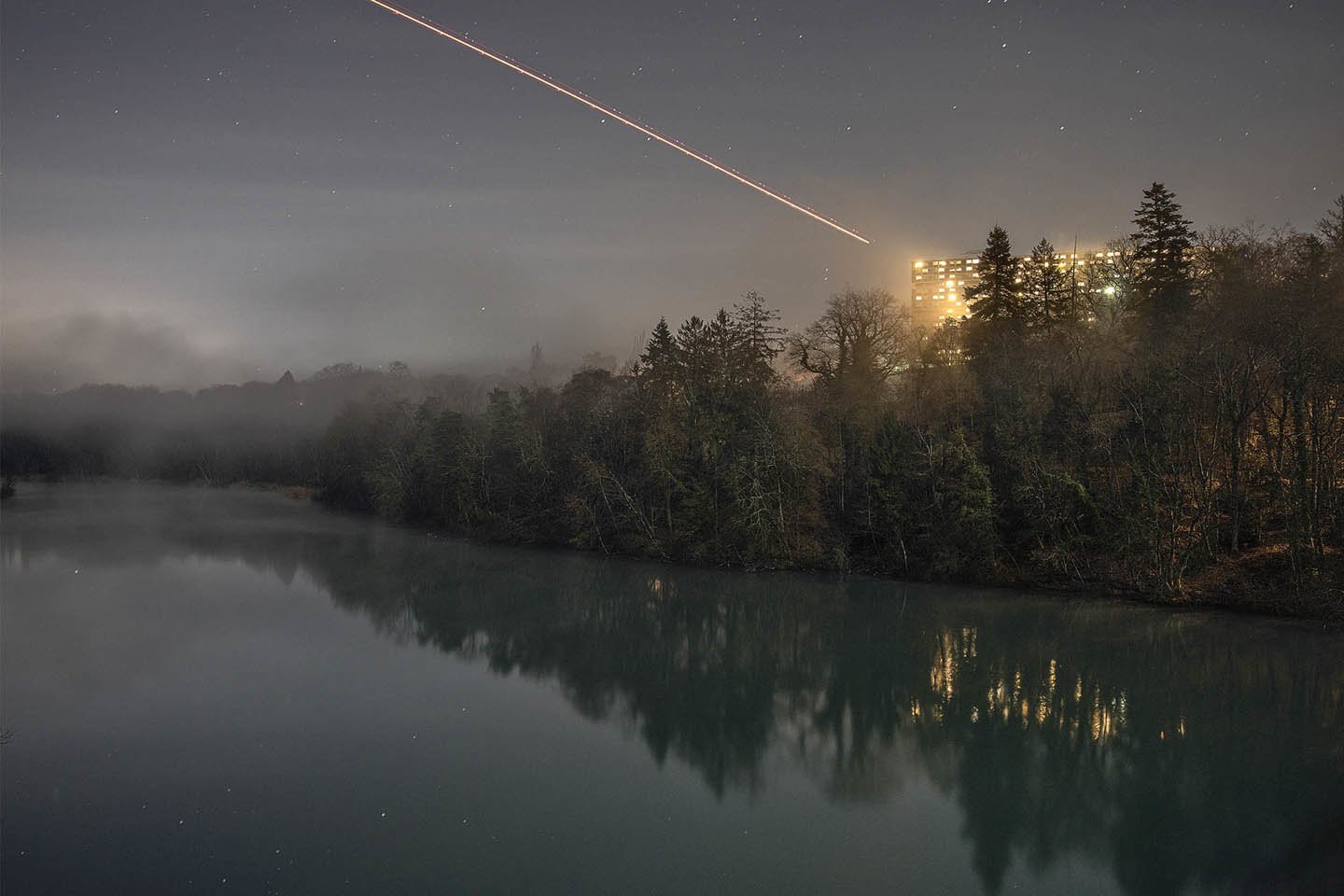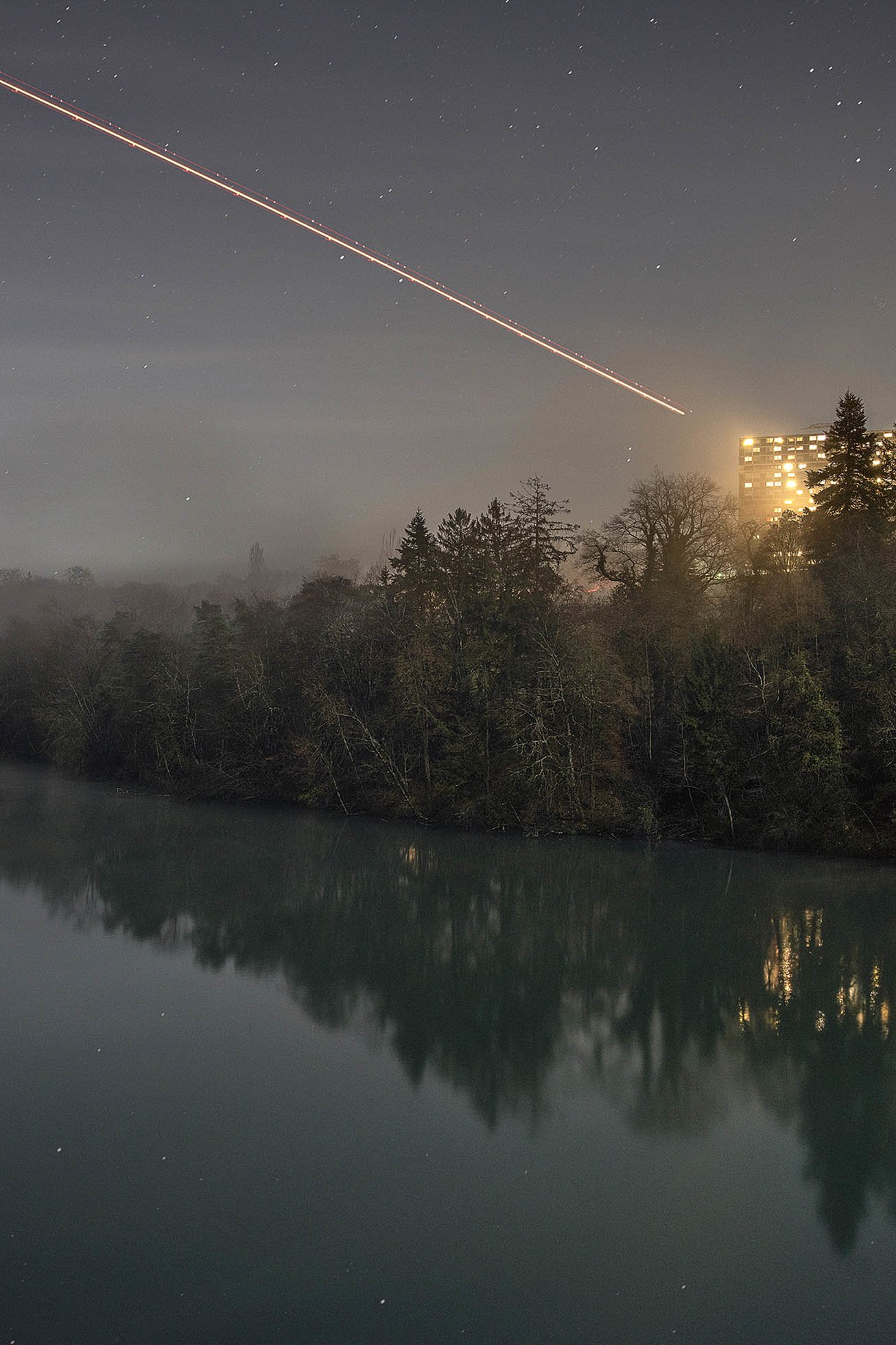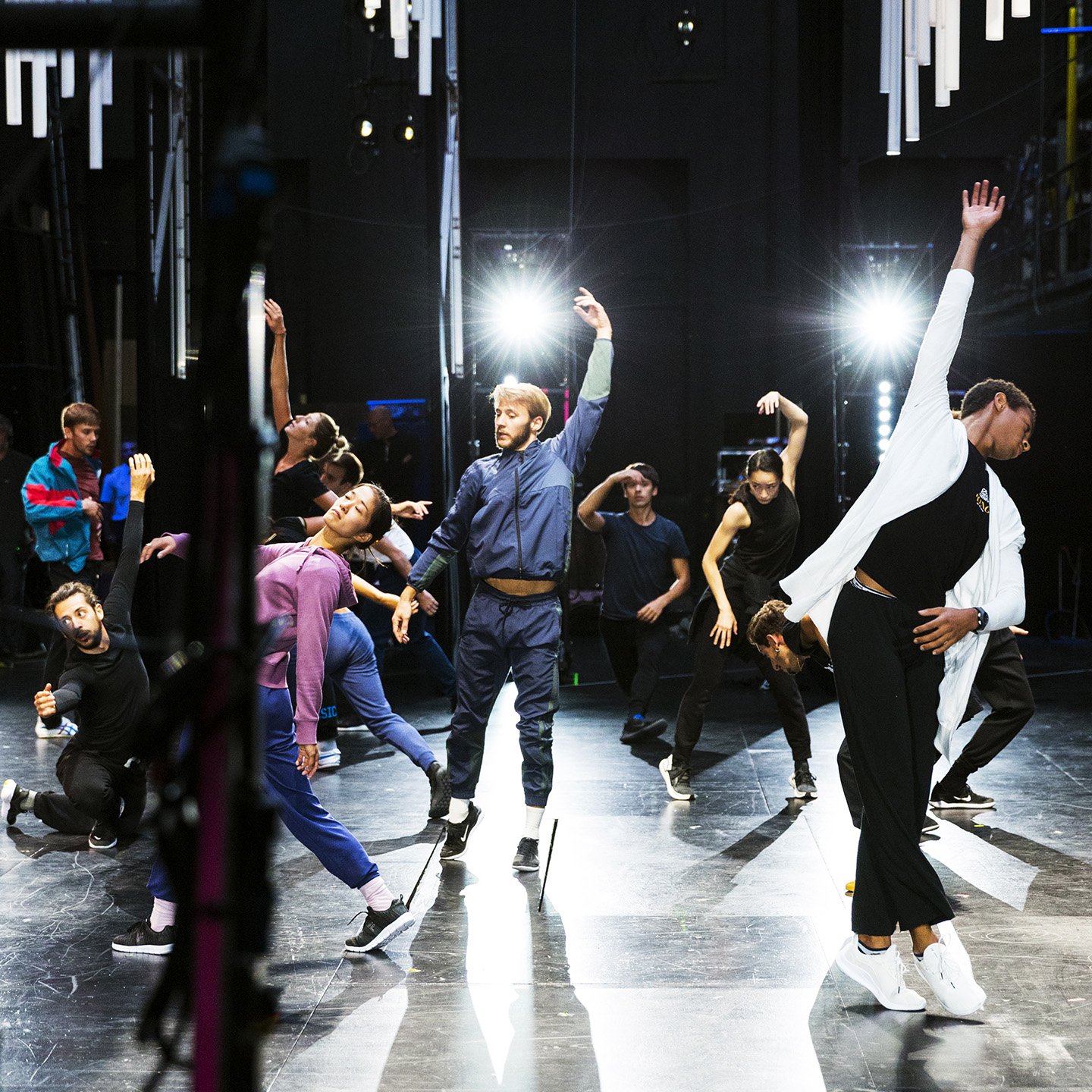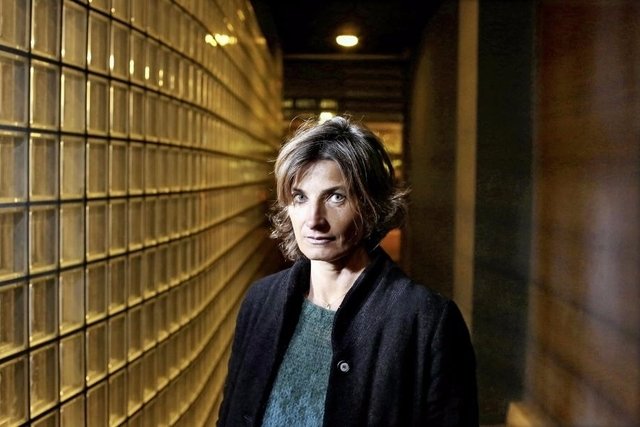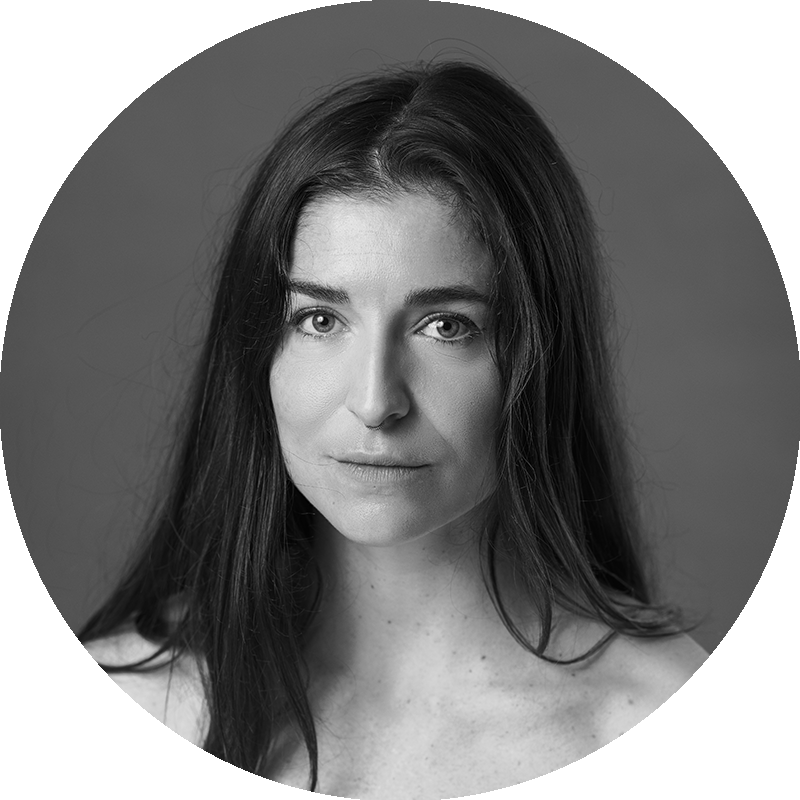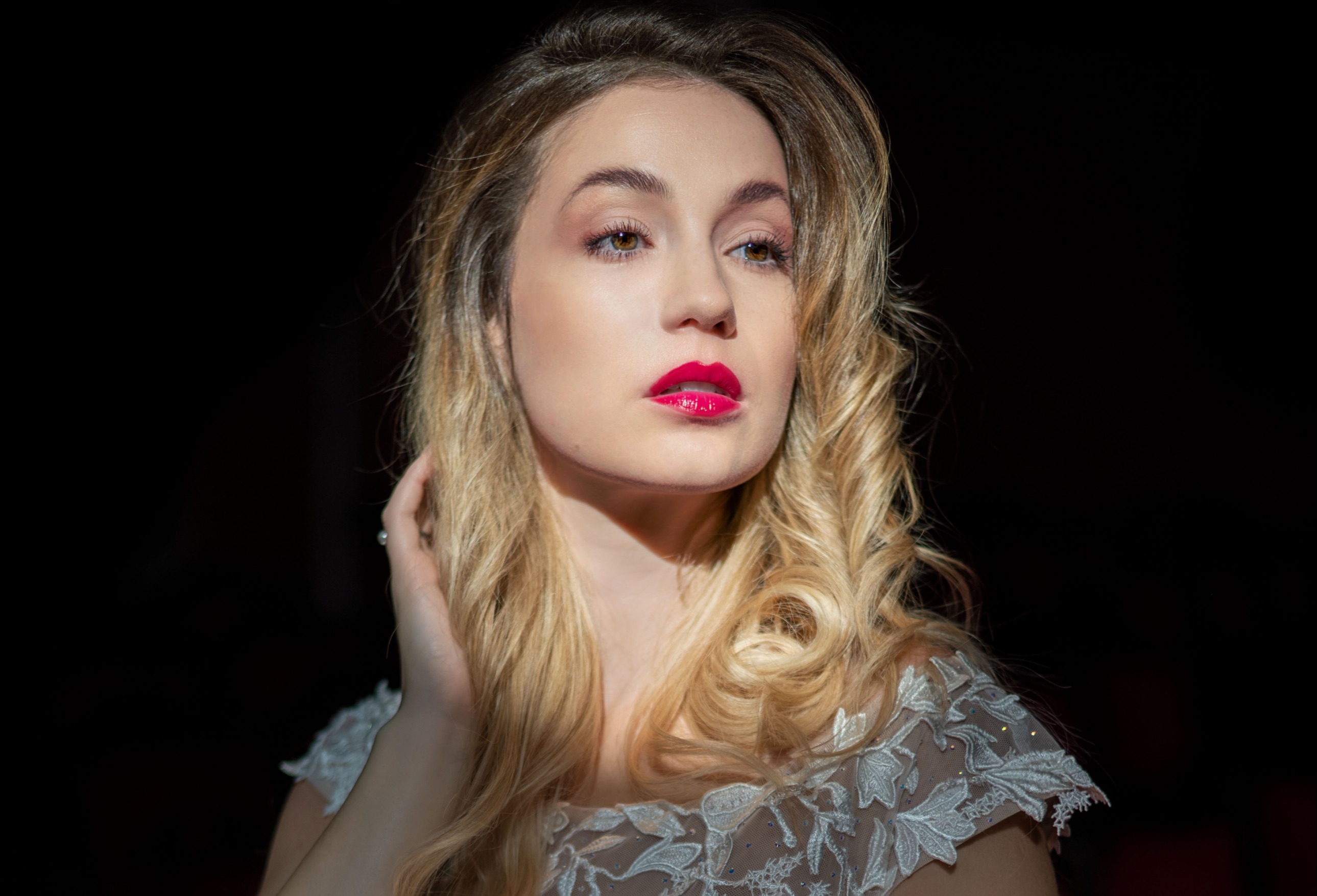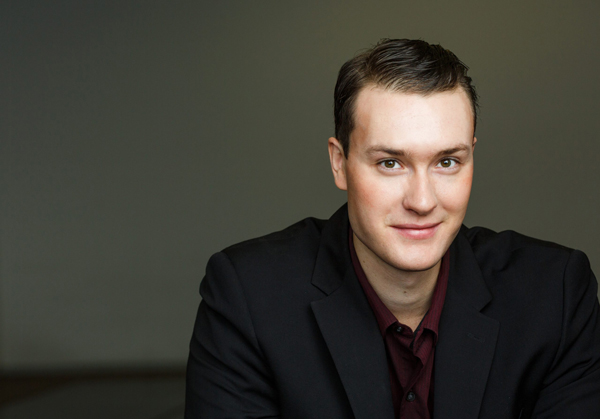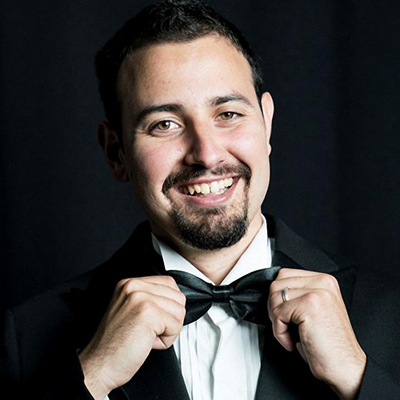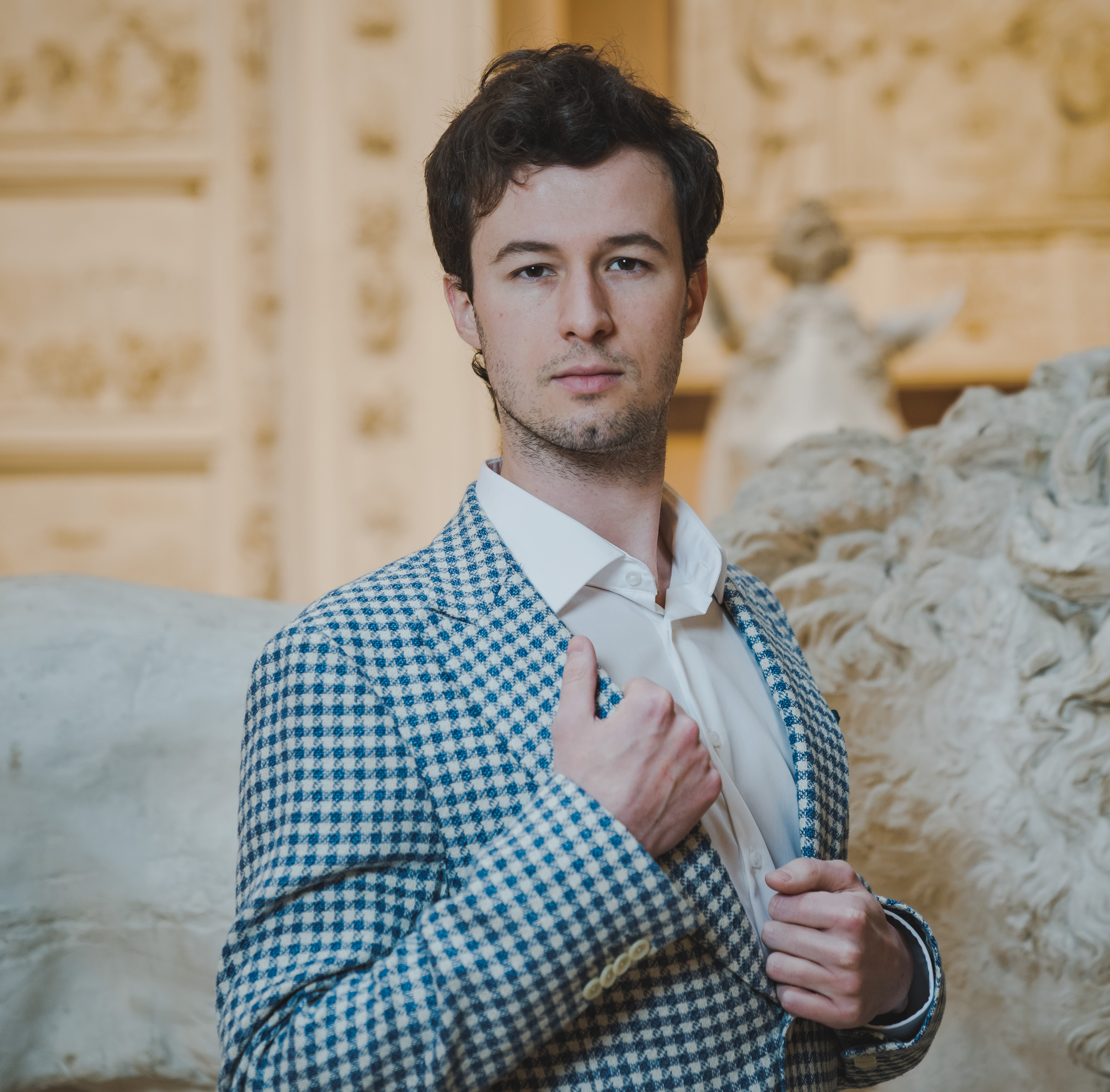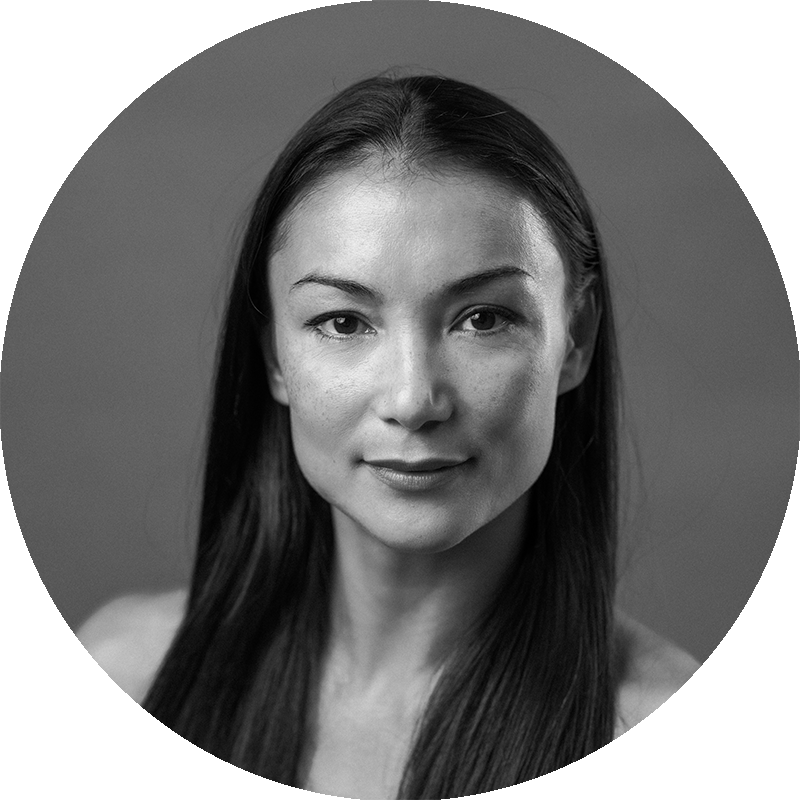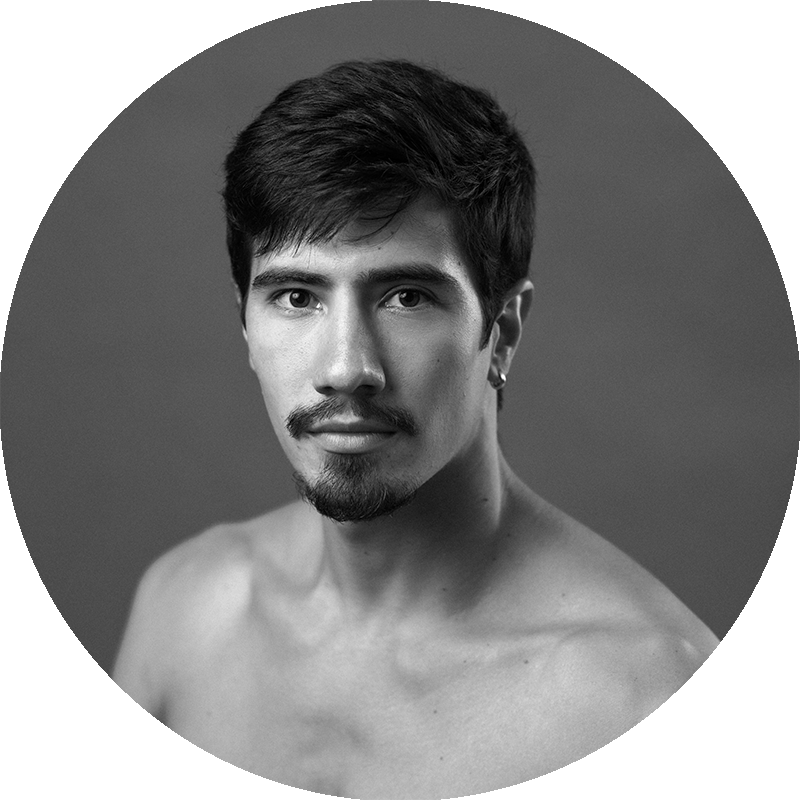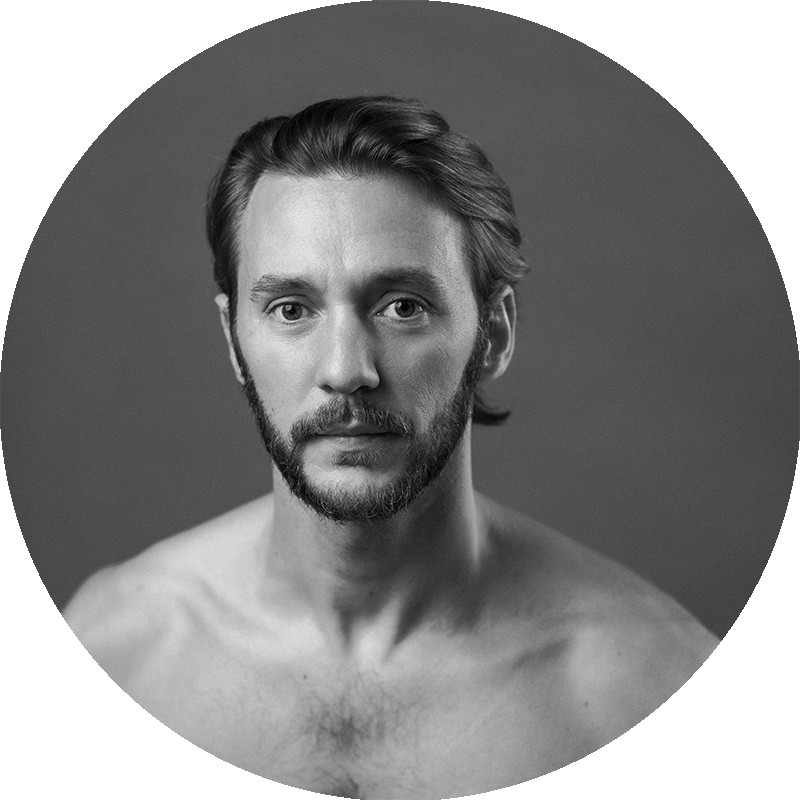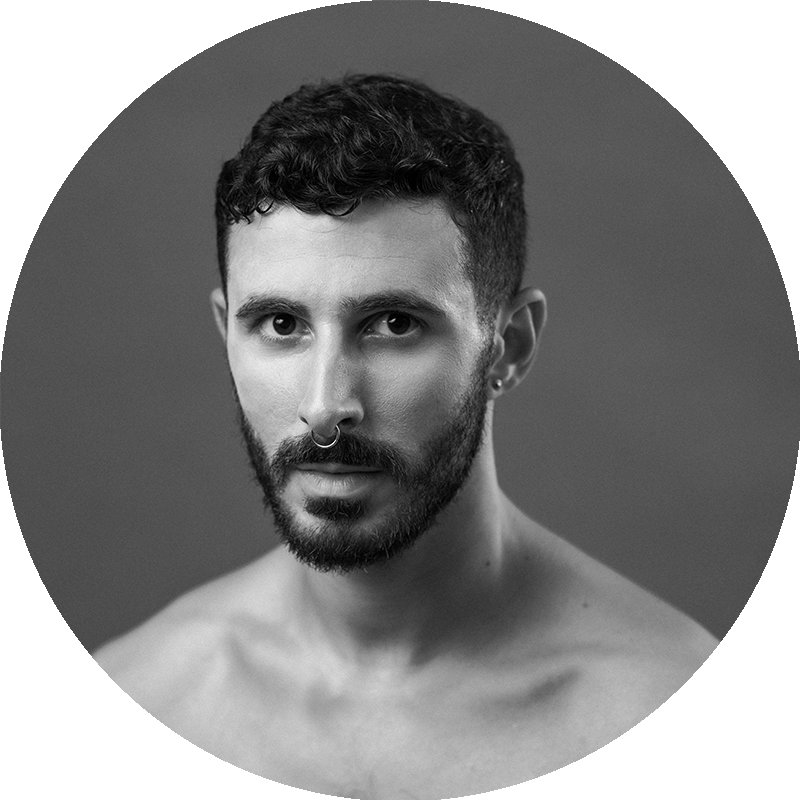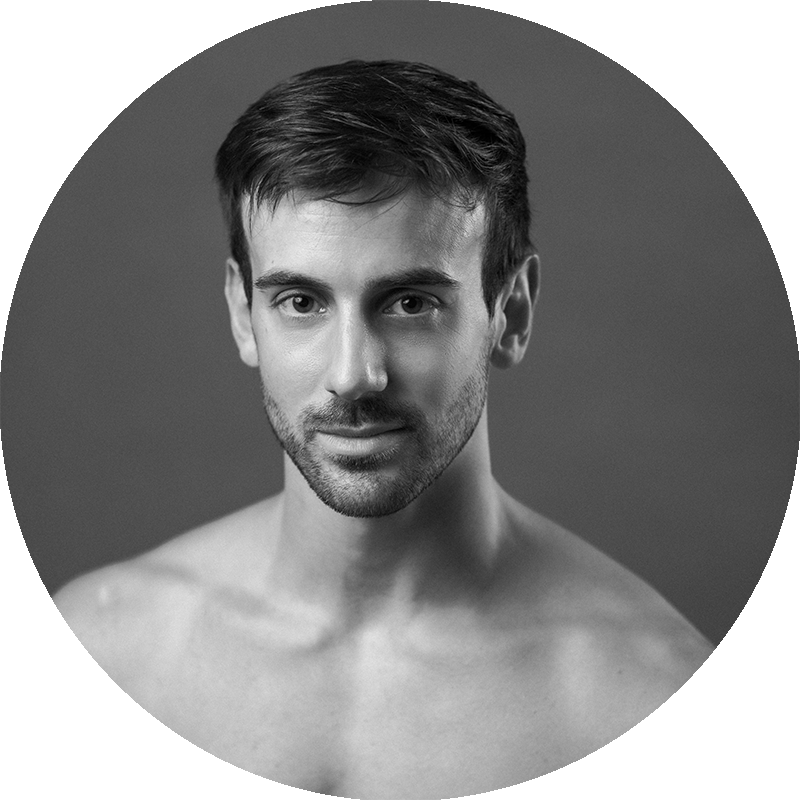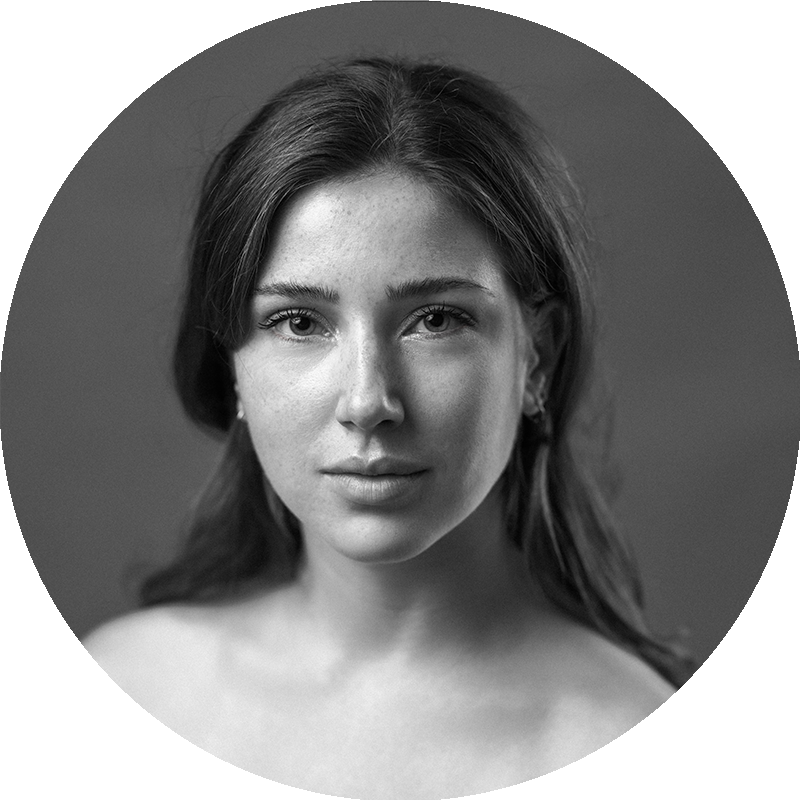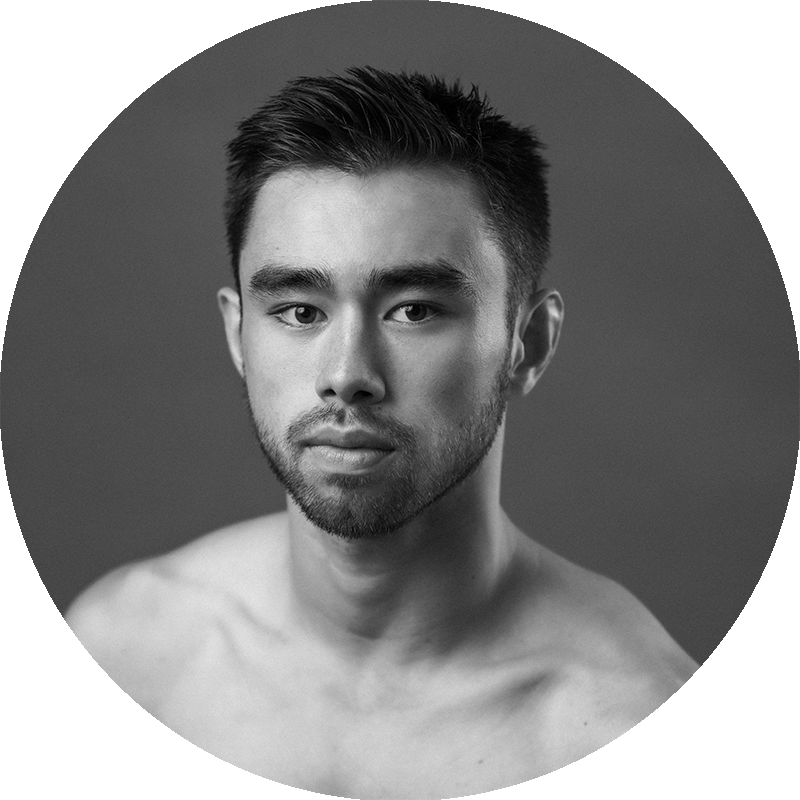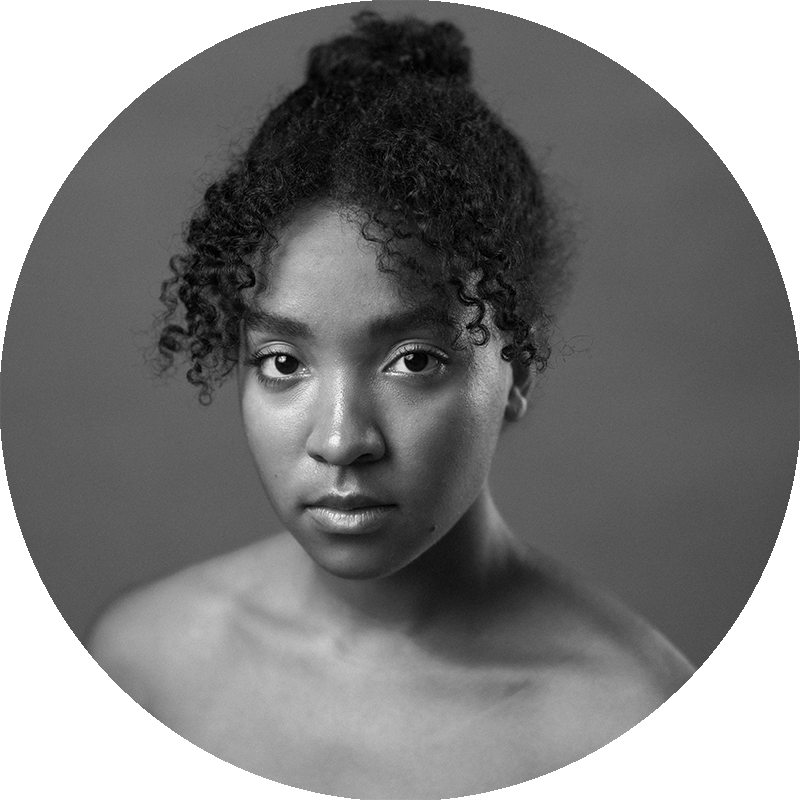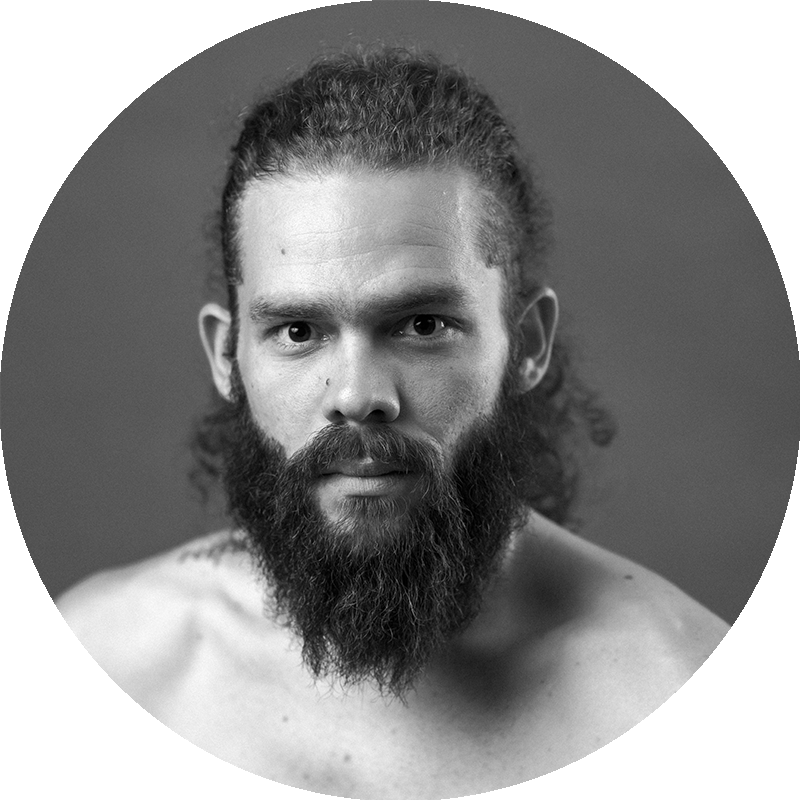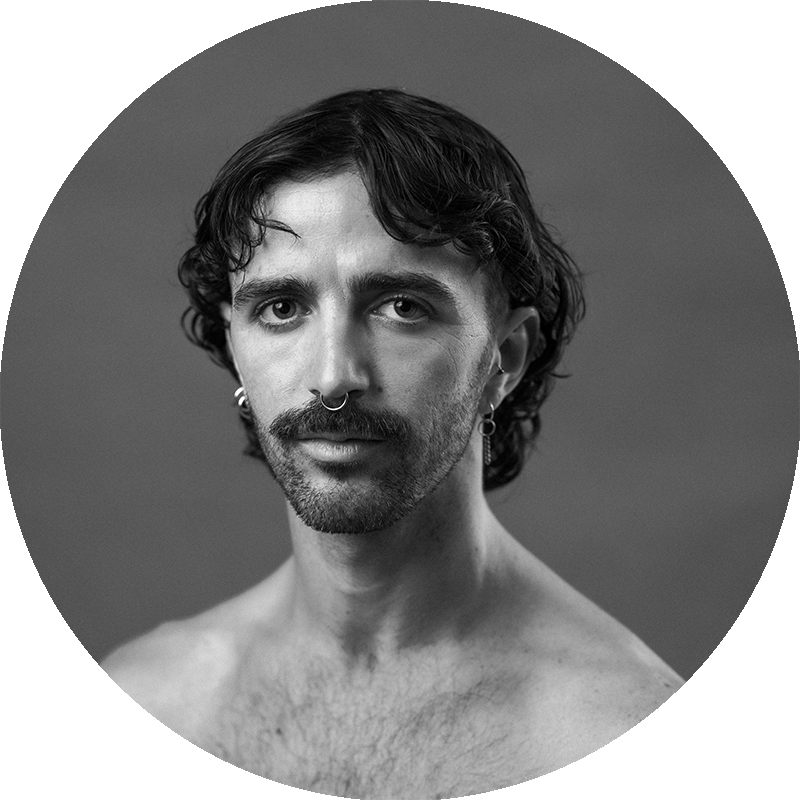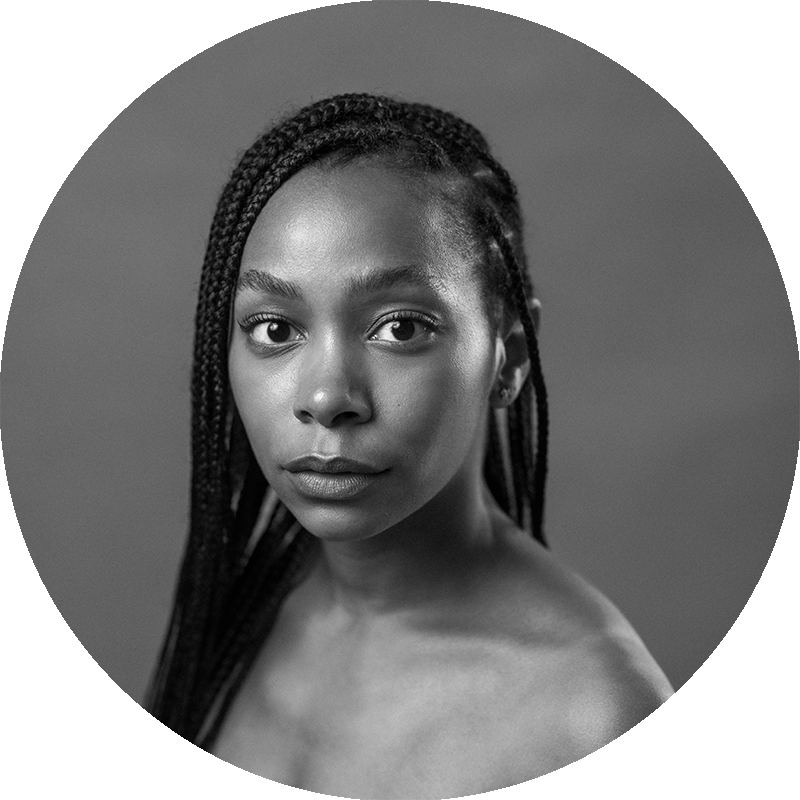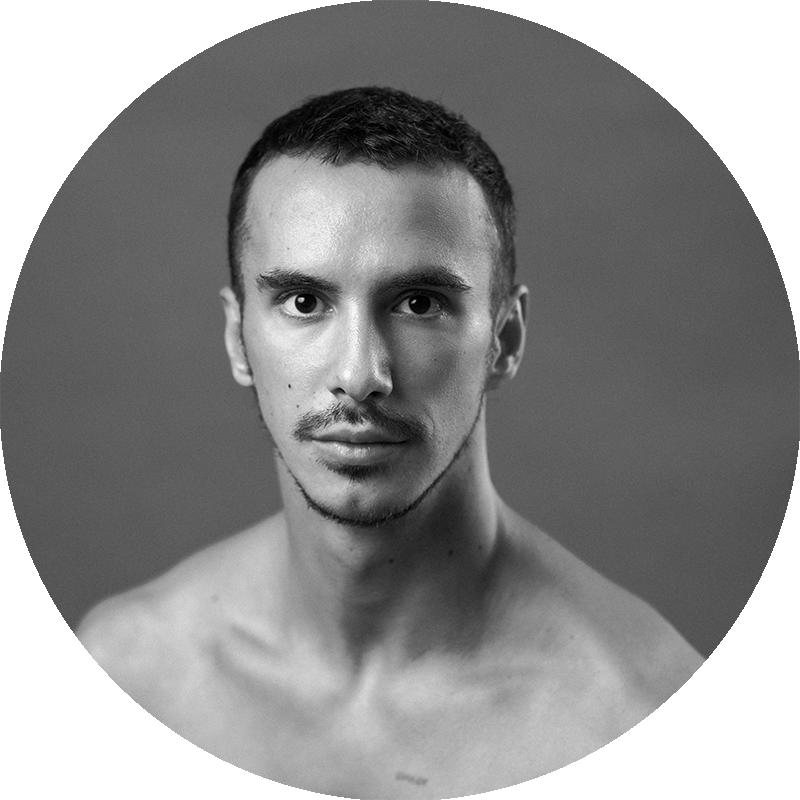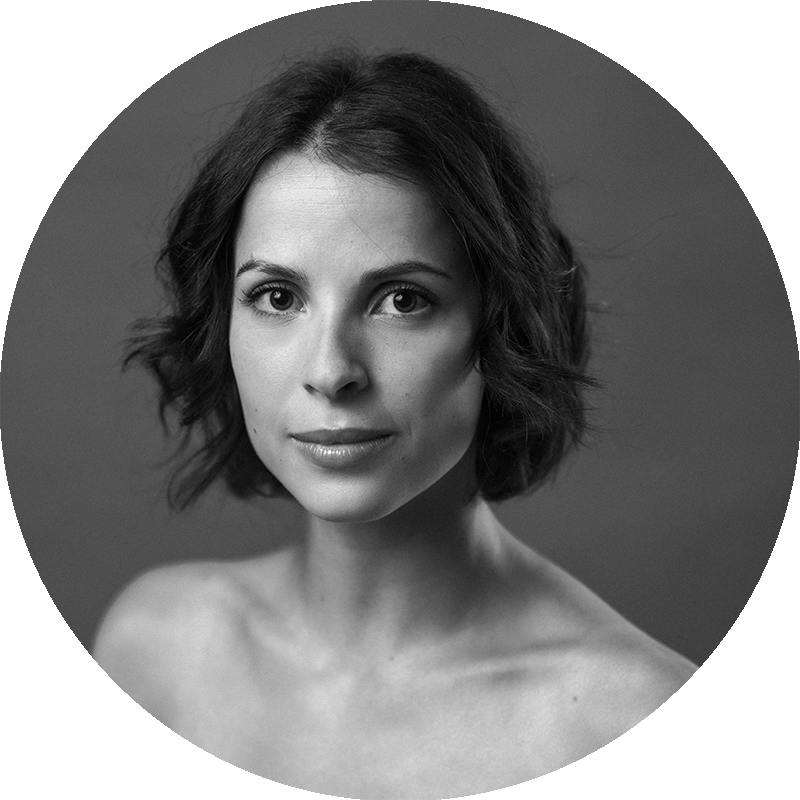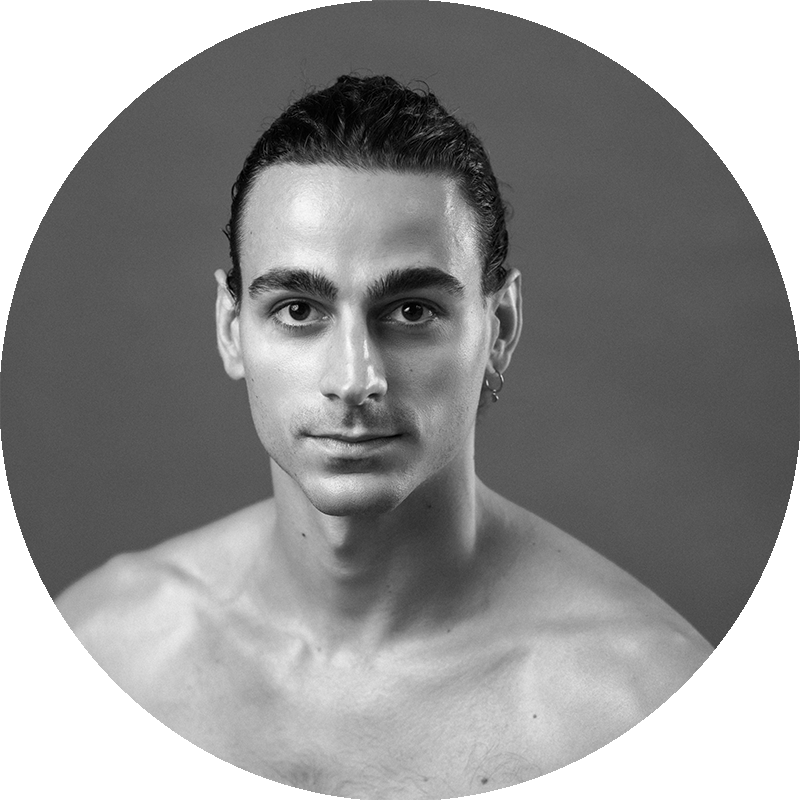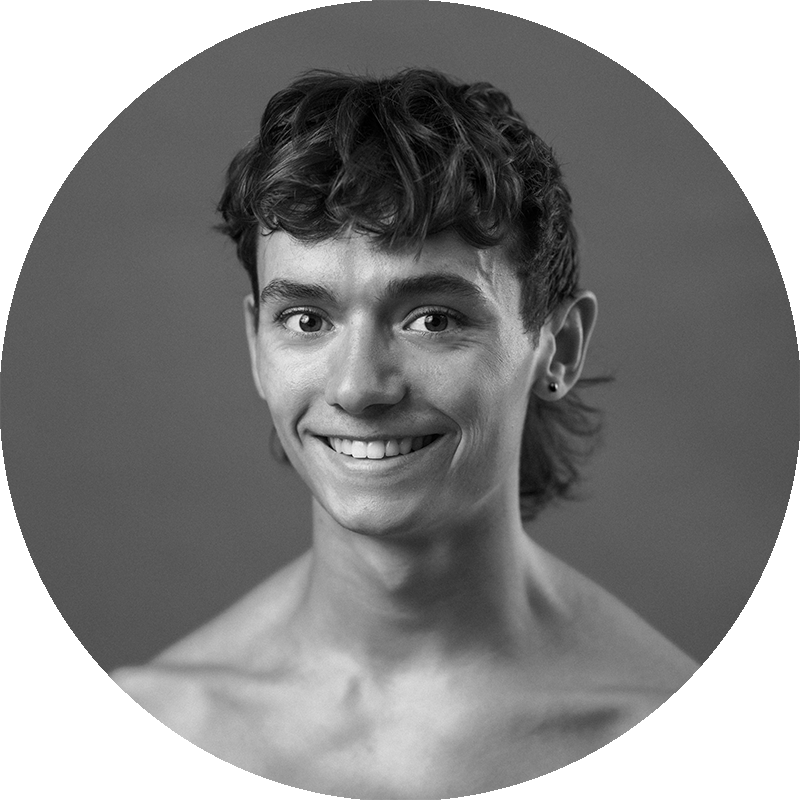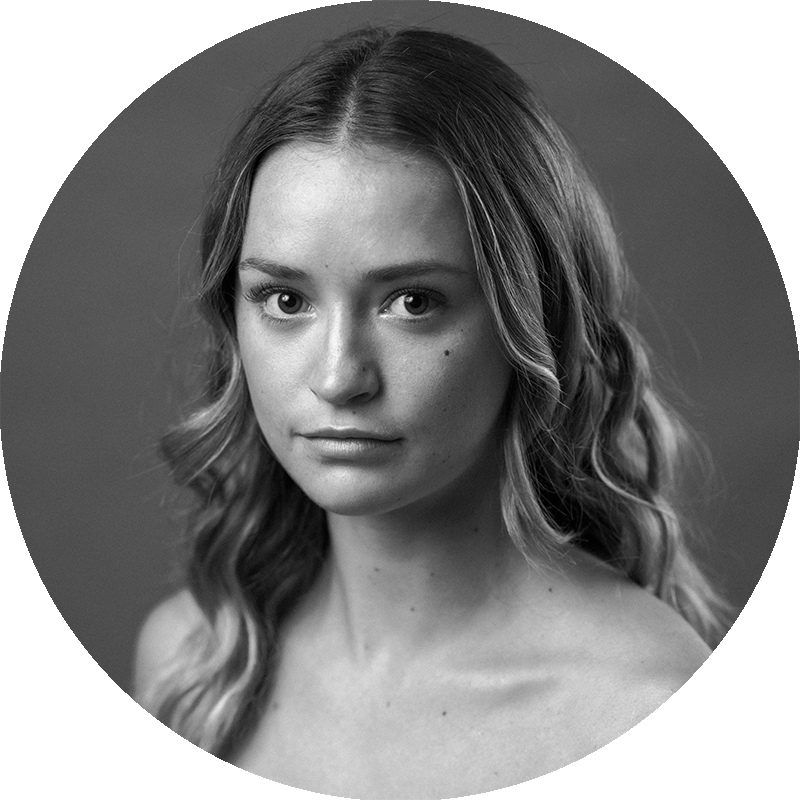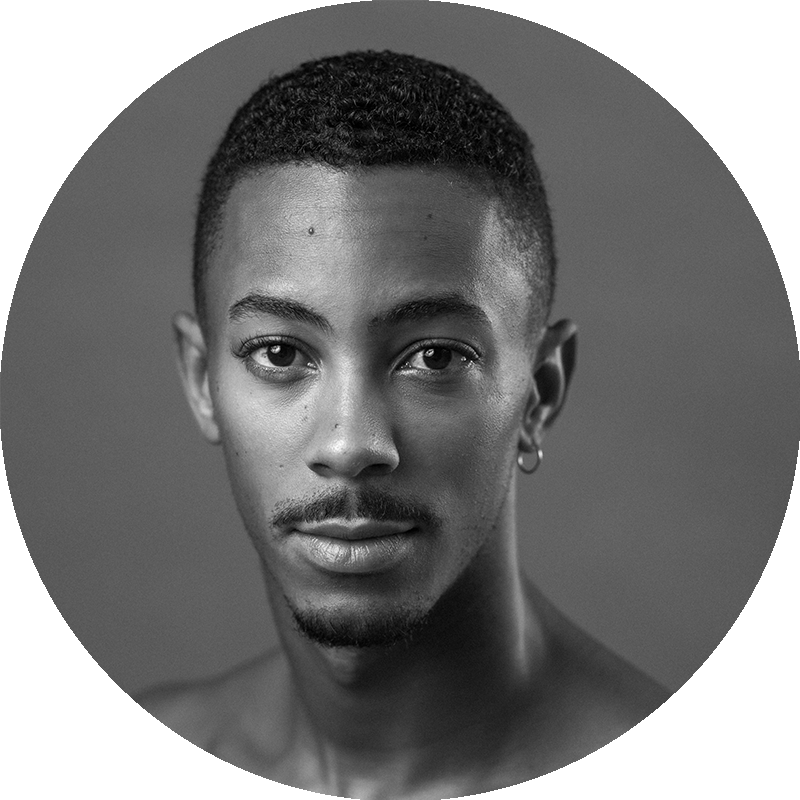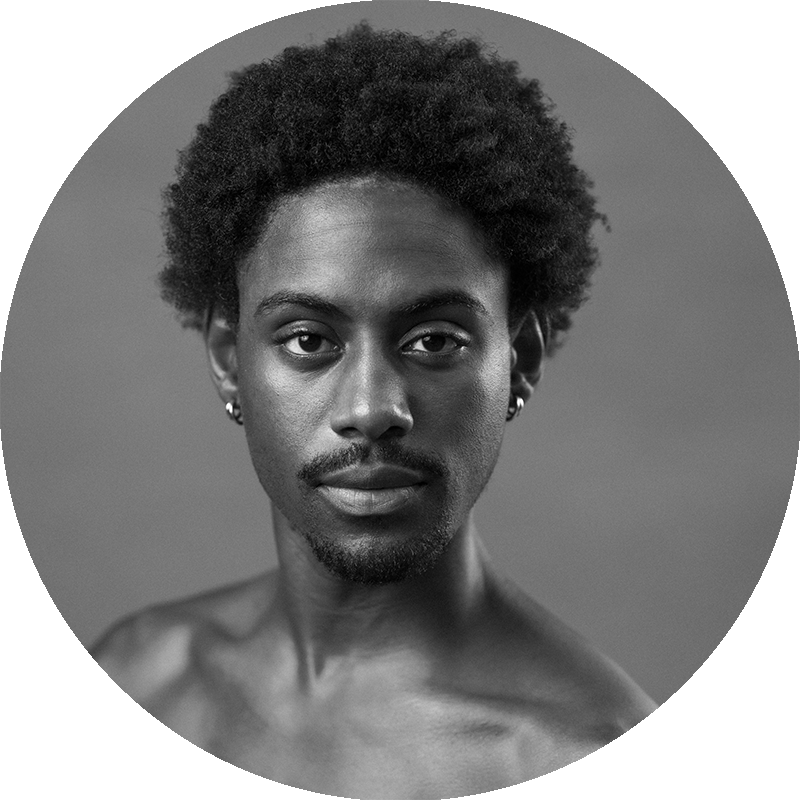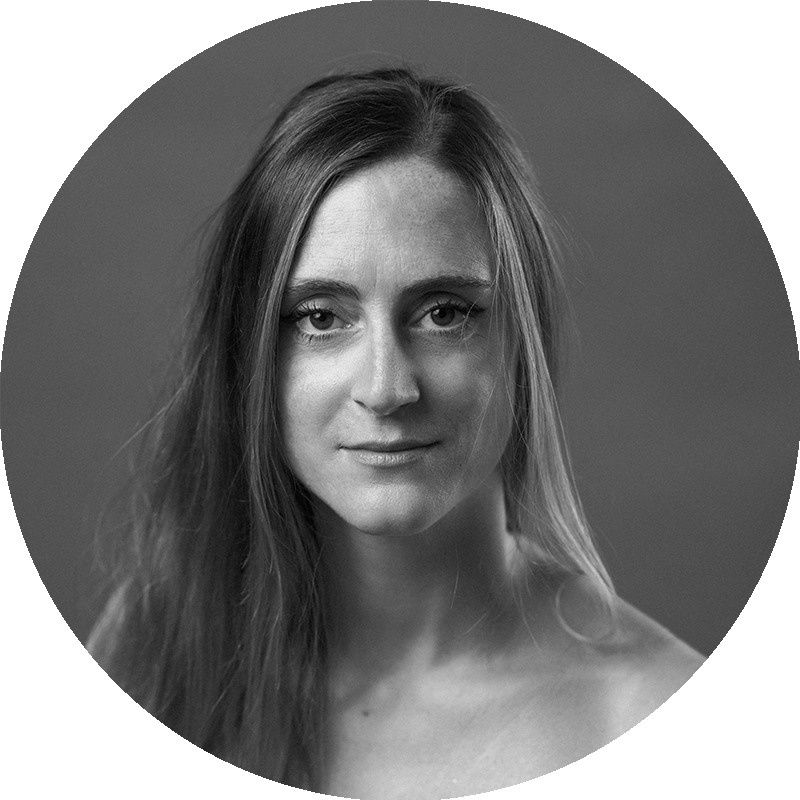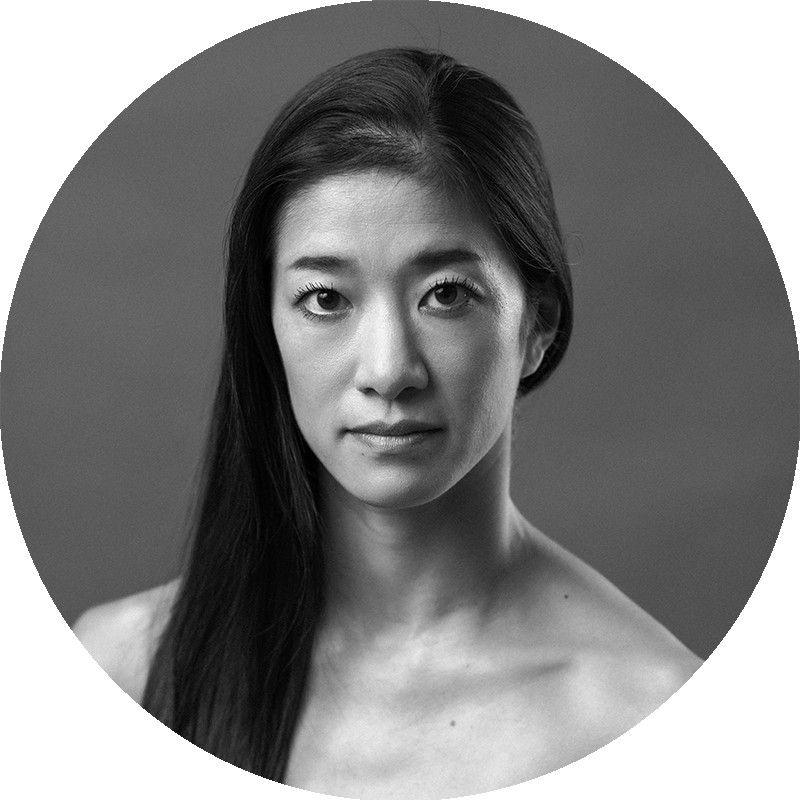
Chien-Shun Liao
Born in Taichung, Taiwan, he trained at the Taipei National University of the Arts and began his professional career with Studio Wayne McGregor in London, performing internationally and collaborating with Needcompany, Jérôme Bel, One Hundred, and Taiwanese choreographer Lai Hung Chung, winning 3rd Prize and the Critics’ Choice Award at the International Choreographic Competition in Hanover. He later joined Ballet BC in Canada and Staatsoper Hannover, performing works by Edward Clug, Sharon Eyal, Marco Goecke, and Alexander Ekman. Member of the Ballet du Grand Théâtre de Genève since 2025.

Chien-Shun Liao
Né à Taichung, à Taïwan, il a suivi une formation à l’Université nationale des arts de Taipei et a commencé sa carrière professionnelle au Studio Wayne McGregor à Londres, se produisant à l’échelle internationale et collaborant avec Needcompany, Jérôme Bel, One Hundred et le chorégraphe taïwanais Lai Hung Chung. Il a remporté le troisième prix et le prix du public au Concours international de chorégraphie de Hanovre. Il a ensuite rejoint le Ballet BC au Canada et le Staatsoper Hannover, où il a interprété des œuvres d’Edward Clug, Sharon Eyal, Marco Goecke et Alexander Ekman. Membre du Ballet du Grand Théâtre de Genève depuis 2025.

Nikita Goile
Originally from Réunion, she trained at the Paris Conservatoire. She then joined the national companies of Malta and Wales. Her interest in creating dance first expressed itself during her time in Wales. She then worked independently with Joy Alpuerto Ritter and Jose Agudo in London, as well as with Eric Languet in Réunion, while founding her own company and producing her first solo. She was then invited to choreograph for the English National Ballet’s Emerging Dancer evening in London. The following year, she joined Castafiore Système, Hani Dance Company and the Yasaman company in Paris. She also performed in Damien Jalet’s Chiroptera and JR in Paris and collaborated with the immersive music collective Circle of Live at the Barbican. She then joined the Akram Khan Dance Company for its production Thikra. She has been a member of the Ballet du Grand Théâtre de Genève since 2025.

Nikita Goile
Originaire de la Réunion, elle s’est formée au Conservatoire de Paris. Elle rejoint ensuite les compagnies nationales de Malte et du pays de Galles. Son intérêt pour la création la conduit à créer pour la première fois pour la compagnie galloise. Elle travaille ensuite en indépendante avec Joy Alpuerto Ritter et Jose Agudo à Londres, ainsi qu’avec Eric Languet à La Réunion, tout en fondant sa propre compagnie et en produisant son premier solo, puis est invitée à chorégraphier pour la soirée Emerging Dancer de l’English National Ballet à Londres. L’année suivante, elle rejoint Castafiore Système, Hani Dance Company et la compagnie Yasaman à Paris. Elle se produit également dans Chiroptera de Damien Jalet et JR à Paris et collabore avec le collectif musical immersif Circle of Live au Barbican. Elle rejoint ensuite Akram Khan Dance Company pour sa création Thikra. Membre du Ballet du Grand Théâtre de Genève depuis 2025.

Dylan Phillips
Né en 2001 à Adélaïde (Australie), il a commencé sa carrière d’acrobate au sein de la compagnie australienne Gravity and Other Myths, où il a travaillé entre 2018 et 2023. Pendant cette période, il a contribué à la création de cinq œuvres complètes, notamment Out of Chaos… (Helpmann Award for Best Physical Theatre Production, 2019) et The Pulse(2021), qui a été adapté pour servir d’événement d’ouverture des festivals internationaux des arts d’Adélaïde et d’Édimbourg (2022). Il a également créé et interprété ses propres œuvres, présentées en France, en République tchèque et en Australie, notamment un duo de 60 minutes intitulé SISSY (2023). En 2023, il a reçu la bourse Marten Bequest pour étudier à la Rambert School of Ballet and Contemporary Dance à Twickenham. Plus récemment, il s’est produit avec le Théâtre national de Prague et la Fritz Company – Bigi/Paoletti. Membre du Ballet du Grand Théâtre de Genève depuis 2025.

Dylan Phillips
Born in Adelaide, Australia in 2001, he began his career as an acrobat with the Australian company Gravity and Other Myths, where he worked between 2018 and 2023. During this time, he contributed to the creation of five full-length works, notably Out of Chaos… (Helpmann Award for Best Physical Theatre Production, 2019) and The Pulse (2021), which was adapted to serve as the opening event of the Adelaide and Edinburgh International Arts Festivals (2022). He has also created and performed his own work, presented in France, the Czech Republic, and Australia, including a 60-minute duet titled SISSY (2023). In 2023, he received the Marten Bequest Scholarship to study at the Rambert School of Ballet and Contemporary Dance in Twickenham. More recently, he has performed as a dancer with the National Theatre of Prague and Fritz Company – Bigi/Paoletti. Member of the Ballet du Grand Théâtre de Genève since 2025.
Teresa Iervolino
Mezzo-soprano
Reconnue au niveau international comme l’une des principales voix du Bel Canto et du Baroque, Teresa Iervolino est aujourd’hui l’une des artistes les plus appréciées sur la scène lyrique mondiale. En 2012, elle remporte le concours AsLiCo, suivi d’autres succès comme la victoire de concours internationaux tels que le concours Maria Caniglia et le concours Etta Limiti. Elle collabore régulièrement avec de chefs d’orchestre du calibre de Riccardo Chailly, Antonio Pappano, Daniel Harding, Fabio Luisi, Roberto Abbado, Alberto Zedda, Christophe Rousset, Jean-Christophe Spinosi, Ivor Bolton, Donato Renzetti, Carlo Rizzi, Marc Minkowski, Stefano Montanari, Andrea Marcon, Ottavio Dantone, Alessandro De Marchi, Antonino Fogliani, Marco Armiliato, Daniel Oren, Daniele Rustioni, Riccardo Frizza.
Parmi ses succès les plus récents, on peut citer Tancredi à Rouen, L’Italiana in Algeri à Cagliari, Ariodante à Martina Franca, la Neuvième Symphonie de Beethoven sous la direction de Michele Spotti pour l’ouverture du Festival MiTo à Turin et La Cenerentola au Teatro del Maggio de Florence avec Gianluca Capuano.
Parmi ses prochains engagements figurent Madama Butterfly et Giulio Cesare au Liceu de Barcelone ; Lucrezia Borgia à l’Opéra de Rome ; Madama Butterfly avec l’Orchestre Philharmonique de Berlin sous la direction de Kirill Petrenko à Baden Baden et Berlin ; Alcina à Versailles ; Stabat Mater de Rossini avec l’Accademia Nazionale di Santa Cecilia sous la direction de Myung-Whun Chung à Rome et au Wiener Konzerthaus.
———
Internationally hailed as one of the leading voices for Bel Canto and Baroque, Teresa Iervolino is today one of the most sought after artists on the world operatic stage. In 2012, she won the AsLiCo Competition, which was then followed by more success winning international competitions such as the Maria Caniglia Competition and the Etta Limiti Prize Competition. She regularly collaborates with conductors of the caliber of Riccardo Chailly, Antonio Pappano, Daniel Harding, Fabio Luisi, Roberto Abbado, Alberto Zedda, Christophe Rousset, Jean-Christophe Spinosi, Ivor Bolton, Donato Renzetti, Carlo Rizzi, Marc Minkowski, Stefano Montanari, Andrea Marcon, Ottavio Dantone, Alessandro De Marchi, Gabriele Ferro, Antonino Fogliani, Marco Armiliato, Daniel Oren, Daniele Rustioni, Riccardo Frizza.
Her most recent successes include Tancredi in Rouen, L’Italiana in Algeri in Cagliari; Ariodante in Martina Franca; Beethoven’s Symphony n.9 under Michele Spotti for the opening of the MiTo Festival in Turin; and Cenerentola at the Teatro del Maggio in Florence with Gianluca Capuano.
Future engagements include Madama Butterfly and Giulio Cesare at the Liceu in Barcelona; Lucrezia Borgia at the Rome Opera; Madama Butterfly with the Berliner Philharmoniker under Kirill Petrenko in Baden Baden and Berlin; Alcina in Versailles; Rossini’s Stabat Mater with the Accademia Nazionale di Santa Cecilia under Myung-Whun Chung in Rome and at the Wiener Konzerthaus.

Ena Pongrac
Mezzo-soprano
The Croatian mezzo-soprano Ena Pongrac trained at the Universities of the Arts in Graz and Berlin, furthering her training with the likes of Christa Ludwig, Gundula Janowitz, Brigitte Fassbaender and Anne Sofie von Otter. In 2016, she made her debut as Zerlina (Don Giovanni) at the Jyväskylän Ooppera in Finland, where she returned as Mercedes (Carmen) the following season. In 2017/18, she played Hänsel (Hänsel und Gretel) at the Junge Oper Schloss Weikersheim. Contemporary roles are also part of her repertoire, such as Madame Lapérouse in Melusine by Aribert Reimann and Lana in Exit Paradise by Arash Safaian. During the 2018/19 season, Ena Pongrac was a member of the Opernstudio OperAvenir at Theater Basel, where she sang, among other roles, Alisa in Lucia di Lammermoor, Trommler in Der Kaiser von Atlantis, Dinah in Trouble in Tahiti and Kate Pinkerton in Madama Butterfly, followed the following season by roles in Andersens Erzählungen and Schellen-Ursli. In 2020/21, she is a member of the Theater Basel ensemble. At the Grand Théâtre, as a member of the Young Ensemble, she appeared in the 22/23 season in Maria Stuarda (Anna Kennedy) Parsifal (Une fille fleur et 2ème Écuyer) and Nabucco (Fenena).
© DR

William Meinert
Bass
William Meinert’s awards include first prize in the Shreveport Opera Mary Jacobs Smith Singer of the Year 2022 competition and the Houston Grand Opera Eleanor McCollum Competition 2019. He recently graduated from Washington National Opera’s Cafritz Young Artist program, where he sang Sarastro in Die Zauberflöte and the Secret Police Agent in The Consul. He has sung the Commendatore in Don Giovanni, the Commentator in Derrick Wang’s Scalia/ Ginsburg, Vodník in Rusalka and the Duke in Romeo and Juliet. As artist-in-residence at Santa Fe Opera, he played Hjarne and Corbin in the world premiere of Poul Ruders‘ The Thirteenth Child in 2019. He has performed in Beethoven’s 9th Symphony, Monteverdi’s Vespers and Handel’s Messiah. William Meinert is a member of the Young Ensemble du Grand Théâtre de Genève.

Omar Mancini
Tenor
In October 2018, he made his debut as solo tenor in Rossini’s Petite Messe solennelle as part of the 150th anniversary of the composer’s death. In September 2019, Omar Mancini made his debut at the Capri Opera Festival with the role of Rinuccio in Gianni Schicchi. In 2021, he graduated cum laude in chamber vocal music from the Conservatorio Giuseppe Verdi in Milan. In November 2021, he was selected for the Bottega Donizetti at the Donizetti Opera, where he sang in the show C’erano una volta due bergamaschi…. In December 2021, he played the Guardian in Acquaprofonda by Giovanni Sollima at the Teatro Sociale in Como. In January 2022, he was Horatio / La Voix imaginaire de Lélio in Lélio ou le Retour à la vie by Berlioz at the Teatro Regio in Turin. He also sang Il Conte Bandiera in Salieri’s La scuola de’ gelosi at Turin’s Teatro Regio in May 2022 and at the Festival della Valle d’Itria in July 2022. Omar Mancini is a member of the Jeune Ensemble du Grand Théâtre.

Giulia Bolcato
Soprano
Soprano Giulia Bolcato has already interpreted a number of leading roles, including Euridice in L’Orfeo and Belinda in Dido & Aeneas. She has also played roles such as Fanny in La cambiale di matrimonio, Sofia in Il signor Bruschino, Ninetta in La Gazza ladra and Elvira in Rossini’s L’italiana in Algeri. She made her debut in the role of the Queen of the Night at the Royal Swedish Opera, then sang Gilda in Rigoletto at the Teatro Regio in Parma, Serpina in La serva padrona and Lucy in Menotti’s The Telephone at the Teatro Pergolesi in Jesi. She also sang Dinah in Bernstein’s Trouble in Tahiti and Oscar in Verdi’s Un ballo in maschera. This summer she will perform the role of Gabriel in Haydn’s Creation at the Salzburg Festival. A member of the Jeune Ensemble du Grand Théâtre, next season she will perform the roles of La voix du Ciel in Don Carlos and Marianne in Le Chevalier à la rose.

Luca Bernard
Tenor
Born in Zürich, lyric tenor Luca Bernard gained his first stage experience as a member of the Zürich Sängerknaben, where he sang the role of Zweiter Knabe in Mozart’s Die Zauberflöte at the Opernhaus Zürich. He is the recipient of a study prize from the Prof. Armin Weltner Foundation and the Migros Kulturprozent. From 2019 to 2021, Luca Bernard was a member of the International Opera Studio Zürich. During the 2021/22 season, he sang at Opera Maggio Fiorentino as Gastone (La Traviata), Jaquino (Fidelio) and Scaramuccio (Ariadne auf Naxos). The following season, he played Fracasso in Mozart’s early opera La finta semplice. In 2022, Luca Bernard took on the role of Ernesto in Donizetti’s Don Pasquale at the Glyndebourne Festival. During the 2023/24 season, he will appear in Klagenfurt, Toulon and at the Grand Théâtre de Genève.

Luca Bernard
Ténor
Né à Zürich, le ténor lyrique Luca Bernard a acquis ses premières expériences sur scène en tant que membre du Zürich Sängerknaben où il a notamment chanté le 2e Knabe dans Die Zauberflöte de Mozart à l’Opéra de Zürich. Il a étudié le piano et la composition à la ZHdK avant de se lancer dans le chant professionnellement. En 2017, il chante Ottokar de Der Zigeunerbaron à l’Operettenbühne Hombrechtikon. Au même endroit, il incarne Stanislas de Der Vogelhändler en 2018. Au cours des saisons 2019/20 et 2020/21, on l’a entendu dans une grande variété de rôles à l’Opéra de Zurich en tant que membre de l’International Opera Studio. Au cours de la saison 2021/22, il a chanté à l’Opéra Maggio Fiorentino de Florence, où il a interprété Gastone (La traviata), Jaquino (Fidelio) et Scaramuccio (Ariadne auf Naxos). Au Festival de Glyndebourne 2022, le ténor lyrique Luca Bernard est intervenu dans le rôle d’Ernesto dans Don Pasquale. Lors de la saison 23/24, il se produit à Klagenfurt, Toulon, ainsi qu’au Grand Théâtre de Genève, où il fait partie du Jeune Ensemble. Des oratorios tels que la Passion selon saint Matthieu de Bach, La Création de Haydn, ses Quatre saisons ou le Stabat mater de Dvořák sont des œuvres centrales de son répertoire.

Madeline Wong
Née en Australie, elle rejoint après sa formation le Ballet du Grand Théâtre de Genève sous la direction de Philippe Cohen, où elle se produit avec de nombreux chorégraphes de renom, créant notamment une version solo du Sacre du printemps de Stravinsky pour Andonis Foniadakis en 2007. Elle s’est ensuite installée à New York pour travailler pour le Cedar Lake Contemporary Ballet pendant deux ans, jusqu’à sa fermeture. Elle a ensuite été invitée à revenir danser pour le Ballet du Grand Théâtre de Genève en 2015, où elle a participé à de nombreuses productions mémorables, prenant notamment le rôle d’Isolde dans Tristan & Isolde de Joëlle Bouvier. Membre du Ballet du Grand Théâtre de Genève depuis 2006.
© Gregory Batardon

Nahuel Alejandro Vega
Né en 1992 à Mar del Plata en Argentine, il s’est formé à l’École du Théâtre Bolchoï au Brésil, à l’Atelier de danse contemporaine du Théâtre San Martin à Buenos Aires, ainsi qu’au Cannes Jeune Ballet de l’École supérieure de danse de Cannes Rosella Hightower en France- Il a reçu le prix Jorge Tomin du meilleur interprète du festival Danzamerica en 2010 et le prix Julio Bocca à Buenos Aires. Il a également participé au Prix de Lausanne en 2011. Sa curiosité pour des nouvelles techniques et vocabulaires corporels l’ont emmené à participer à de grands festivals en Europe comme le Deltebre Dansa, IDW Budapest, entre autres. Il a rapidement obtenu le diplôme d’État français de professeur en danse contemporaine. Membre du Ballet du Grand Théâtre de Genève depuis 2013.
© Gregory Batardon

Geoffrey van Dyck
Né en 1990 et d’origine française, il commença la danse à l’âge de 10 ans avec le hip hop et le Modern Jazz dans une petite école du nord-est de la France. Pris de passion pour cet art, il décide à 18 ans de rejoindre l’Académie Internationale de la Danse à Paris où il étudiera le classique, le contemporain, le jazz, le chant et la comédie. Durant ses deux annés de formation, il participera à des comédies musicales (Grease, Mozart l’Opera Rock) et à divers événements comme la Semaine de la mode ou 10 ans de Smart habillé par Hermès.
Afin d’approfondir ses connaissances, il se rend à Lyon pour intégrer le Conservatoire national supérieur de musique et de danse où il étudiera la danse contemporaine pendant 3 ans. Lors de sa troisième année, il passe l’audition publique du Ballet du Grand Théâtre de Genève. Membre du Ballet du Grand Théâtre de Genève depuis 2013.
© Gregory Batardon

Sara Shigenari
Née à Yokohama, au Japon, elle poursuit sa formation de danseuse auprès de Setsuko Honda. Après avoir obtenu son diplôme à l’English National Ballet School, elle a rejoint le Cannes Jeune Ballet où elle a eu l’occasion de danser dans des productions à l’Opéra de Nice et à l’Opéra d’Avignon. Depuis qu’elle a rejoint le Ballet du Grand Théâtre de Genève, elle a travaillé avec des chorégraphes tels que Sidi Larbi Cherkaoui, Damien Jalet, Mats Ek, Jiří Kylián, Andonis Foniadakis, Angelin Preljocaj et Joëlle Bouvier, pour n’en citer que quelques-uns. Membre du Ballet du Grand Théâtre de Genève depuis 2009.
© Gregory Batardon

Luca Scaduto
Né sur la côte ouest de la Sicile, il a commencé sa formation professionnelle en danse en 2013 et a été diplômé de l’académie de danse Professione Danza Parma en 2015 en ballet classique impérial (niveau avancé 2). En 2019, il est également professeur qualifié de ballet classique impérial. En tant que danseur contemporain, il a travaillé pour plusieurs compagnies de danse : Agora Coaching Project, Valencia Dancing Forward, Fondazione Teatro Regio di Parma, Croatian National Theater Ballet Split, pour n’en citer que quelques-unes, et a dansé pour des chorégraphes tels que Sidi Larbi Cherkaoui, Ivan Alboresi, Patricia Apergi, Gustavo Ramirez, Asun Noales, Ricardo Fernando et Diego Tortelli. Pour que sa carrière reste polyvalente et dynamique, il s’est également produit dans la production de West Side Story de l’ensemble Costa Cruise Line et de La Cage Aux Folles au Theater Ulm. Membre du Ballet du Grand Théâtre de Genève depuis 2022.
© Gregory Batardon

Juan Perez Cardona
Né à Llauri (Valence, Espagne). Il commence à étudier la danse à l’École nationale de danse de Marseille, puis rejoint le Cannes Junior Ballet. Il obtient son premier contrat professionnel en tant que danseur au sein du Ballet de Lorraine en 2016. L’année suivante, il est engagé par Philippe Cohen pour rejoindre la Compagnie du Ballet de Genève où il a dansé dans des pièces de Joëlle Bouvier, Jiří Kylián, Jeroen Verbruggen, Damien Jalet, Angelin Preljocaj, Andonis Foniadakis et Sidi Larbi Cherkaoui. Membre du Ballet du Grand Théâtre de Genève depuis 2017.
© Gregory Batardon

Stefanie Noll
Née à Kiev, en Ukraine, et élevée aux États-Unis. Elle a reçu sa formation dans le cadre du Joffrey Trainee Program et du Arts Umbrella Graduate Program. Au cours de sa carrière professionnelle, elle a travaillé avec Ballet BC à Vancouver (Canada), et pour la compagnie de danse-théâtre immersive Punchdrunk, où elle a participé à la création originale de la production The Burnt City. Elle a également participé au processus de création de Body and Soul de Crystal Pite au Ballet de l’Opéra de Paris et à un programme de mentorat chorégraphique sous la direction de Pite. Elle a travaillé en étroite collaboration avec des chorégraphes tels que Mehdi Walerski, Crystal Pite, Maxine Doyle, Alejandro Cerrudo et Alexandra Damaini, et a interprété des œuvres de Johan Inger, Sharon Eyal, Mats Ek, Andonis Foniadakis et Amos Ben-Tal. Membre du Ballet du Grand Théâtre de Genève depuis 2023.
© Gregory Batardon

Léo Merrien
Né à Rennes en Bretagne, il est diplômé du Conservatoire national de Paris en danse contemporaine, où il continue en première année de master. Il a travaillé ensuite au Centre chorégraphique national de Rennes dans le collectif hip-hop FAIR-E. Quelques années plus tard, Léo travaille avec Damien Jalet pour la recherche chorégraphique d´un film qui sortira en 2024. Il a également participé à différents projets commerciaux, notamment pour une vidéo promotionnelle pour la marque Off-White, pour la maison Issey Miyake lors de la Semaine de la mode de Paris, pour la marque d´hôtel de luxe Fairmont pour une soirée privée à Doha, une vidéo promotionnelle pour la Galerie Perrotin, pour le musée national du Qatar : Il a dansé pour le clip Flamme de Juliette Armanet, ainsi que pour la danseuse, chorégraphe et acrobate aérienne Satchie Noro. Il a également créé un duo de danse lors d’une résidence à l’Espace Pasolini. Membre du Ballet du Grand Théâtre de Genève depuis 2023.
© Gregory Batardon

Emilie Meeus
Née à Anvers en 2000, Emilie se passionne très jeune pour la danse et intègre à l’âge de dix ans l’école du Ballet Royal d’Anvers et poursuit ses études de danse au Lycée artistique d’Anvers. Pendant ces années elle travaillera avec des chorégraphes comme Anton Lachky, Sidi Larbi Cherkaoui et Roberto Olivan, En 2017 elle intègre le Ballet Junior de Genève où elle interprètera des pièces d’Olivier Dubois, Hofesh Shechter, Barak Marshal, Alexander Ekman, Maguy Marin et Rachid Ouramdane. Elle rejoint ensuite le Ballet de Lorraine en 2019 où elle restera trois saisons sous la direction de Petter Jacobsson. Elle y dansera des pièce de Merce Cunningham, Trisha Brown, Maud Lepladec, Loic Touzé, Latifa Laâbissi. Membre du Ballet du Grand Théâtre de Genève depuis 2022.
© Gregory Batardon

Julio José León Torres
Né en 1993 à Granma (Cuba). Il commence sa carrière sportive en tant que gymnaste mais en 2005, il entame des études de danse à l’École nationale d’art pendant six ans. En 2011, il termine ses études avec un haut niveau technique et devient danseur professionnel à Danza Contemporánea de Cuba jusqu’en 2015. Il est l’un des membres fondateurs de la compagnie Acosta Danza dirigée par l’artiste Carlos Acosta jusqu’en 2019. Il a dansé des pièces de chorégraphes tels que Sidi Larbi Cherkaoui, Jan Linkens, Itzik Galili, Juan Cruz, George Céspedes, Julio Cesar Iglesia, Justin Peck, Goyo Montero, entre autres. En tant que danseur indépendant (2021-2023), il a remporté des prix lors de concours et de festivals tels que Masdanza, IODC Canada, Burgos New York, Vallecasdanza, Cortoindanza, Danza en el Camino, entre autres. Membre du Ballet du Grand Théâtre de Genève depuis 2023.
© Gregory Batardon

Mason Kelly
Originaire de Geelong, en Australie, il a été formé à la New Zealand School of Dance. Il a travaillé avec de nombreuses compagnies australiennes de premier plan, notamment avec Dancenorth, où il a effectué des tournées nationales et internationales dans des œuvres de Kyle Page et Amber Haines, Lucy Guerin et Gideon Obarzanek, Alisdair Macindoe, Ross McCormack, Stephanie Lake, Lee Serle et Kristina Chan. Il a également travaillé avec l’Australian Dance Theatre, Chunky Move, a joué dans Collision de Jo Lloyd (une collaboration entre Tasdance et GUTS dance), JAGAD de Monica Lim, Melanie Lane et Rianto, ainsi que dans d’autres œuvres de Cass Mortimer Eiper & Charmene Yap, Lewis Major, Joel Bray, Luigi Vescio et de l’artiste Jemima Lucas. Membre du Ballet du Grand Théâtre de Genève depuis 2023.
© Gregory Batardon

Zoe Hollinshead
Originaire d’Atlanta (États-Unis), elle nourrit un amour pour la danse et la performance dès son plus jeune âge. En 2019, elle obtient un diplôme de bachelor en danse à la Juilliard School de New York, sous la direction d’Alicia Graf Mack. Elle a ensuite rejoint l’Opera Ballet Vlaanderen sous la direction de Sidi Larbi Cherkaoui, où elle s’est produite dans des œuvres de Sidi Larbi Cherkaoui, Akram Khan, Pina Bausch, Crystal Pite, William Forsythe, Jermaine Maurice Spivey, Anna Teresa De Keersmaker, entre autres. Elle a également participé à des projets avec des créatifs indépendants anversois et des organisations dirigées par des minorités telles que Black Lives Matter Belgium, INCONNU et The Cope, et a pris part à de multiples résidences qui ont abouti à la fois à des spectacles en direct et à deux films de danse. Membre du Ballet du Grand Théâtre de Genève depuis 2022.
© Gregory Batardon

Armando Gonzalez Besa
Né à La Havane, Cuba, Armando Gonzalez Besa a commencé sa formation en ballet à l’Escuela Provincial Alejo Carpentier. Après avoir déménagé à Miami, aux États-Unis, il a obtenu un diplôme de la New World School of the Arts et, en 2005, une licence en journalisme de l’Université internationale de Floride. Il a dansé lors de la saison inaugurale du Ballet Gamonet et a rejoint peu après le Royal Winnipeg Ballet au Canada en tant que danseur soliste. La saison suivante, il a rejoint le Staattheather Augsburg en Allemagne. Cela fait quatorze saisons qu’il danse au Ballet de Genève. Père de deux jeunes enfants, sa femme et lui apprécient beaucoup l’émerveillement avec lequel Gaël et Mila découvrent le monde. Membre du Ballet du Grand Théâtre de Genève depuis 2010.
© Gregory Batardon

Ricardo Gomes Macedo
Né en 1995 à Lisbonne, il avait étude à l’école de danse du Conservatoire national de Lisbonne. À l’origine plus attiré par le ballet, il passe deux années au conservatoire de La Haye, où il découvre le répertoire contemporain. Il débute sa vie professionnelle en 2013 dans la Cie Introdans à Arnhem (Pays-Bas). Après un passage de 2016 à 2017 au Zürich Junior Ballett, où il danse le rôle du Maure dans Petrouschka de Marco Goecke, suivi d’une année au sein de la Compagnie nationale de Ballet du Portugal. Attiré par les aspects abstraits et organiques de la danse contemporaine, il entre en 2018 au Ballet de l’Opéra de Lyon pendant quatre saisons, où il dansera dans des pièces de Jiří Kylián, William Forsythe, Alessandro Sciarroni, Peeping Tom et Anne Teresa de Keersmaeker. Membre du Ballet du Grand Théâtre de Genève depuis 2020.
© Gregory Batardon

Diana Dias Duarte
Née à Lisbonne, au Portugal. Elle commence sa formation à l’Escola Artística do Conservatório Nacional en 2008, y étudie et y obtient son diplôme après huit ans d’études. En 2015, elle rejoint le Ballet de Nuremberg, sous la direction de Goyo Montero. Elle y a dansé dans des chorégraphies de Goyo Montero, Christian Spuck, William Forsythe et Mauro Bigonzetti, entre autres. Elle est engagée par Philippe Cohen pour rejoindre le Ballet du Grand Théâtre de Genève où elle a l’occasion de danser dans des œuvres de Natalia Horecna, Jeroen Verbruggen, Andonis Foniadakis, Jiri Kylian, ainsi que de nombreux autres chorégraphes de renom. Membre du Ballet du Grand Théâtre de Genève depuis 2017.
© Gregory Batardon

Oscar Comesaña Salgueiro
Né dans la ville côtière galicienne de Vigo en Espagne, il commence à étudier la danse dans sa ville natale. À l’âge de 18 ans, il déménage ensuite à Madrid, pour poursuivre sa formation en ballet soutenue par diverses bourses à l’école de ballet Victor Ullate. En 2017, Oscar rejoint la Compagnie Victor Ullate où il danse pendant trois saisons, figurant dans des pièces chorégraphiées par Victor Ullate lui-même ainsi que par le collectif Kor’sia. Dans la foulée, il rejoint le National Ballet of Ireland, où il danse dans Minus 16 d’Ohad Naharin lors du festival de danse 2020 Bold Moves à Dublin. Membre du Ballet du Grand Théâtre de Genève depuis 2020.
© Gregory Batardon

Quintin Cianci
Né et élevé à Montréal, au Québec, il a étudié la danse à la prestigieuse institution canadienne de l’École royale de ballet de Winnipeg. Après avoir obtenu son diplôme, il arrive à Genève pour rejoindre l’Area Jeune Ballet pendant un an. Il est ensuite engagé par Philippe Cohen pour rejoindre le Ballet du Grand Théâtre de Genève, se produisant dans Casse-Noisette de Jeroen Verbruggen dans le rôle du Roi des rats, ainsi que dans des œuvres d’Andonis Foniadakis, Joëlle Bouvier et Claude Brumachon. Membre du Ballet du Grand Théâtre de Genève depuis 2021.
© Gregory Batardon

Zoé Charpentier
Parisienne de naissance, elle grandit dans le sud de la France où elle débute la danse dans une école privée et en classe horaire aménagée avec le Conservatoire d’Aix en Provence. Elle continue sa formation au Conservatoire national supérieur de musique et de danse de Paris (CNSMDP) en parallèle de son cursus lycéen puis universitaire. Après l’obtention de son diplôme, elle poursuit une année de danse au Junior Ballet du CNSMDP. À l’issue de cette année, elle intègre l’Opéra de Lyon sous la direction de Yourgos Loukos où elle interprète des pièces de chorégraphes tels que Jiří Kylián, Trisha Brown, Lucinda Childs, Merce Cunningham, Maguy Marin, etc. Elle rejoint ensuite le Ballet Preljocaj à Aix-en-Provence pour deux saisons. Membre du Ballet du Grand Théâtre de Genève depuis 2022.
© Gregory Batardon

Anna Cenzuales
Née à Ravenne, en Italie, où elle a grandi et étudié jusqu’à l’âge de 18 ans. En 2021, elle déménage à Vancouver, au Canada, pour suivre le programme postsecondaire Arts Umbrella sous la direction d’Artemis Gordon. En 2022, elle participe au Nederland Dans Theater Summer Intensive et, la même année, a l’occasion de partir en tournée aux Pays-Bas avec la Arts Umbrella Dance Company et de jouer The Season Canon de Crystal Pite à l’Opéra néerlandais d’Amsterdam. Pendant son séjour à Arts Umbrella, elle a interprété des œuvres du répertoire de Crystal Pite, William Forsythe, Johan Inger, Fernando Magadan et Marco Goecke. Membre du Ballet du Grand Théâtre de Genève depuis 2023.
© Gregory Batardon

Adelson Carlos
Brésilien de naissance et fier de son héritage africain, il est originaire de la ville de Salvador de Bahia. Il s’est formé pendant neuf ans au ballet à la célèbre école Bolchoï du Brésil. En 2017, il s’installe en Suisse avec une bourse pour étudier à la compagnie de danse junior Cinevox basée à Schaffhouse, où il travaille avec des chorégraphes tels que Heinz Spoerli et Franz Brodmann. L’année suivante, il est engagé par Philippe Cohen pour rejoindre le Ballet du Grand Théâtre de Genève où il danse dans des pièces de Jiří Kylián, Jeroen Verbruggen, Angelin Preljocaj, Andonis Foniadakis et Sidi Larbi Cherkaoui. Au-delà de sa carrière de danseur, il s’est aventuré dans le monde de la publicité, contribuant à diverses campagnes publicitaires pour des banques privées et collaborant avec l’Université de Bâle. Membre du Ballet du Grand Théâtre de Genève depuis 2018.
© Gregory Batardon

Jared Brown
Originaire du Texas, aux États-Unis, il a passé quelque temps à New York pour étudier à la Juilliard School, où il a obtenu son diplôme en 2020. Il a obtenu la reconnaissance de la Fondation nationale YoungArts en danse moderne et en chorégraphie. De plus, il est boursier présidentiel américain 2016 dans les arts, et récipiendaire du prix Princesse Grace 2019, Martyn Ravenhill Liberace Mansion Dance Honor. Il s’est produit et a effectué des tournées avec des compagnies telles que la Hofesh Shechter Company, le Ballett Theater Basel, Richard Siegal/Ballet of Difference, Molissa Fenley and Company, David Dorfman Dance, Douglas Dunn + Dancers, Seán Curran Company, I Kada Contemporary Dance, et Arch Contemporary Ballet. Membre du Ballet du Grand Théâtre de Genève depuis 2023.
© Gregory Batardon

Céline Allain
Née à Châteauroux, elle étudie au conservatoire de Tours, au Ballet du Nord (Roubaix), dans une école privée de danse avec Martine Chaumet et Christian Conte à Bordeaux et à l’école Princesse Grace à Monaco. Elle intègre ensuite le Cannes Jeune Ballet, où elle poursuit sa formation de 2008 à 2012. Elle a commencé à travailler en 2012 en tant que danseuse professionnelle pour le Ballet d’Europe à Marseille et a ensuite rejoint le Ballet de Genève où elle a interprété des œuvres de Ken Ossola, Joëlle Bouvier, Jeroen Verbruggen, Andonis Foniadakis, Cindy Van Acker, pour n’en citer que quelques-unes. Membre du Ballet du Grand Théâtre de Genève depuis 2013.
© Gregory Batardon

Yumi Aizawa
Yumi Aizawa, née à Matsumoto, au Japon, a reçu sa première formation en ballet à l’Académie de ballet Hakucho au Japon, puis à l’École de ballet de Hambourg en Allemagne. Pendant ses années d’école, elle danse occasionnellement dans les productions du Ballet de Hambourg. Après l’obtention de son diplôme à l’âge de 17 ans, elle a commencé sa carrière au sein du Ballet de Dresde où elle a interprété de nombreuses pièces classiques et néoclassiques. Après deux ans au sein du Ballet de Dresde, elle rejoint ensuite le Ballet de l’Opéra national de Bordeaux. En 2009, elle est promue soliste, et en 2012, première soliste, interprétant quelques rôles principaux dans des pièces classiques ainsi que dans des pièces de différents chorégraphes, notamment I. Galili, J. Kylian, W. Forsythe, etc. Membre du Ballet du Grand Théâtre de Genève depuis 2014.
© Gregory Batardon

William Meinert
Basse
William Meinert a remporté le premier prix du concours Shreveport Opera Mary Jacobs Smith Singer of the Year 2022 et de la Houston Grand Opera Eleanor McCollum Competition 2019, et est finaliste de la Loren L. Zachary National Vocal Competition 2022. Il est récemment diplômé du programme Cafritz Young Artist du Washington National Opera, où il a interprété Sarastro dans Die Zauberflöte et le Secret Police Agent dans The Consul. Il a chanté le Commendatore dans Don Giovanni (Baltimore Concert Opera), Commentator dans Scalia/ Ginsburg de Derrick Wang (Opera North), Vodník dans Rusalka (Madison Opera) et le Duc dans Roméo et Juliette de Gounod (Pensacola Opera). En tant qu’artiste en résidence du Santa Fe Opera, il a interprété Hjarne et Corbin lors de la première mondiale de The Thirteenth Child de Poul Ruders en 2019. Il s’est produit dans la 9e Symphonie de Beethoven avec la Baltimore Choral Arts Society, les Vêpres de Monteverdi (de 1610) avec les American Bach Solistes et le Messiah de Händel avec le Washington Bach Consort. Au GTG, membre du Jeune Ensemble, il était le Grand Prêtre du Baal dans Nabucco sur la saison 22/23.

Ena Pongrac
Mezzo-soprano
La mezzo-soprano croate, Ena Pongrac a été formée aux Universités des Arts de Graz et de Berlin et elle approfondit sa formation auprès notamment de Christa Ludwig, Gundula Janowitz, Brigitte Fassbaender ou encore Anne Sofie von Otter. En 2016, elle fait ses débuts en Zerlina (Don Giovanni) au Jyväskylän Ooppera en Finlande, où elle est retournée en Mercedes (Carmen) la saison suivante. En 2017/18, elle incarne Hänsel (Hänsel und Gretel) au Junge Oper Schloss Weikersheim. Les rôles contemporains font aussi partie de son répertoire, comme Madame Lapérouse dans Melusine d’Aribert Reimann et Lana dans Exit Paradise d’Arash Safaian. Au cours de la saison 2018/19, Ena Pongrac a été membre de l’Opernstudio OperAvenir au Theater Basel où elle interprète, entre autres, Alisa dans Lucia di Lammermoor, Trommler dans Der Kaiser von Atlantis, Dinah dans Trouble in Tahiti et Kate Pinkerton dans Madama Butterfly, puis la saison suivante des rôles dans Andersens Erzählungen et Schellen-Ursli. En 2020/21, elle est membre de l’ensemble du Theater Basel. Au Grand Théâtre, membre du Jeune Ensemble, elle s’est produite sur la saison 22/23 dans Maria Stuarda (Anna Kennedy) Parsifal (Une fille fleur et 2ème Écuyer) et Nabucco (Fenena).
© DR
